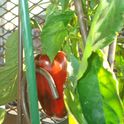I want to make some baked baking soda for ramen noodles but dont have foil or parchment is it okay to go without?
10 Comments
BakerBrenMarch 30, 2019
Ah yes, washing soda... Go for a ceramic or glass dish or use a ceramic-coated metal one like the broiler pan that likely came with your oven. While the process might not damage your bare metal pans, it could.
Heating the baking soda drives out CO2 and increases the pH from baking soda's ~9 to ~11. The resulting washing soda can be used for ramen noodles, and also in place of lye when dipping pretzels before baking lye.
Heating the baking soda drives out CO2 and increases the pH from baking soda's ~9 to ~11. The resulting washing soda can be used for ramen noodles, and also in place of lye when dipping pretzels before baking lye.
HalfPintMarch 30, 2019
Agree with BakerBren. You would not want to do without the baked baking soda. It is what gives ramen noodles it yellow color and springy-ness texture. Without it, I guess you would just have plain noodles, not ramen.
SmaugMarch 30, 2019
Interesting- so you decarbonate sodium bicarbonate what do you have left, sodium monocarbonate? Really should have pursued chemistry past high school.
HalfPintApril 1, 2019
Yes, for the most part. Chemical reaction:
NaHCO3 (sodium bicarbonate aka baking soda) --> Na2CO3 (sodium carbonate) + H2O (water) + CO2 (carbon dioxide)
NaHCO3 (sodium bicarbonate aka baking soda) --> Na2CO3 (sodium carbonate) + H2O (water) + CO2 (carbon dioxide)
SmaugApril 1, 2019
OK then, thanks- I'll have to try that, I'm a big advocate of boiling with baking soda for cleaning burned on gook, maybe this will improve it. Or maybe the same reaction occurs when the solution is boiled. Or maybe I'll never burn on gook again...
SmaugMarch 30, 2019
This is a new one on me- why do you want to bake the baking soda?
Jacob C.March 30, 2019
maybe instead of being rude and insulting people, do a little research online before you spout off about stuff you dont know about? it wouldnt be monocarbonate? it would be sodium carbonate? which makes it a stronger alkali and gives ramen noodles their springyness and color
GammyMarch 31, 2019
Jacob C., the Food52 Hotline page is a place for asking general questions of other cooks, learning new methods and new recipes. Smaug is one of our more knowledgable cooks that replies frequently with good solid answers. I see nothing in either of her posts to indicate rudeness or insult. Please keep your condescending remarks to yourself, they are out of place here.
SmaugMarch 31, 2019
deer jaycob;
In the midst of this garbage, there is a bit of information, which I should have guessed since the two other principle sources of alkalinity that one runs across are lime (calcium carbonate) and lye (potassium carbonate, among other chemicals), so thanks heaps.
In the midst of this garbage, there is a bit of information, which I should have guessed since the two other principle sources of alkalinity that one runs across are lime (calcium carbonate) and lye (potassium carbonate, among other chemicals), so thanks heaps.
creamteaApril 1, 2019
I don't perceive anything insulting in Smaug's comment, just curiosity. Not sure what's got you triggered here.
Showing 10 out of 10 Comments
Recommended by Food52
Popular on Food52
Continue After Advertisement


